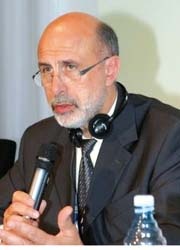Towards more efficient cross-border healthcare in Europe
Unlimited digital communication between European healthcare systems - that's the aim of the European Commission's e-health activities. In particular, an electronic version of the European Health Insurance Card is coming closer. However, the road towards a standardised electronic patient summary is somewhat rockier.

The electronic version of the European Health Insurance Card (EHIC) is being driven forward by the European Commission’s Directorate General for Health and Consumer Affairs (DG SANCO). The introduction of the EHIC some years ago facilitated cross-border reimbursement of healthcare services considerably. But the paper version of the EHIC does have limits: ‘Hospitals do not know if a person with an EHIC is really covered by an insurance company, because it might have expired already,’ says Noel Nader of GIE Sesam-Vitale in France.
Nader is also one of the coordinators of DG SANCO’s EESSI project that aims at establishing an electronic version of the EHIC. This would allow an online insurance verification Europe-wide, so that problems with expired cards could be minimised. EESSI – the bulky acronym for Electronic Exchange of Social Security Information – will be an international IT-network that offers more than 60 standardised electronic documents (SED) relating to health insurance coverage. Health insurance companies that want to take part in the online insurance verification process will do so via national access points that are currently being built up in several European countries.
An online verification will be possible on the base of bilateral or multilateral agreements between European Member States. However, there will be no obligation to take part, neither for a Member State nor for a health insurance company. The idea is that health insurance companies will find the service attractive enough to establish the necessary cooperation with the relevant healthcare providers. This is already happening, in fact: ‘EESSI builds on existing pilot installations like for example the NETC@RDS project’, says Noel Nader.
The EESSI time schedule is pretty ambitious: The technical specifications for the EESSI service and the necessary access points will probably be finished by the end of the year. The infrastructure could be set up over a period of two years or so, with the system being fully operational in 2012.
While the eEHIC is a purely administrative tool, the European electronic patient summary aims at making personal health information digitally accessible in cross-border healthcare. The electronic patient summary is being developed in the epSOS project (Smart Open Services for European Patients) that involves 27 players from twelve European Member States. This project was initiated by the Directorate General for Information Society and Media (DG INFSO). It is backed by ? 11 million funding of the European Commission. Industry is expected to contribute at least as much.
The road is a bit rockier here, since a Europe-wide electronic patient summary requires a high degree of interoperability both technically and semantically between the European healthcare systems. ‘There are still discussions about how to proceed. But the different actors have figured out how to work together and this is a success’, said Gérard Comyn, head of the European Commission’s ICT for Health unit. To gain more political backing, a Europe-wide governance structure for e-health was brought into discussion recently. ‘The topic,’ he said, ‘was discussed very positively at the ministry of state meeting before the eHealth 2009 conference in Prague. It would certainly give additional impetus.’
Details: www.healthtechwire.com/ictforhealth
01.05.2009










